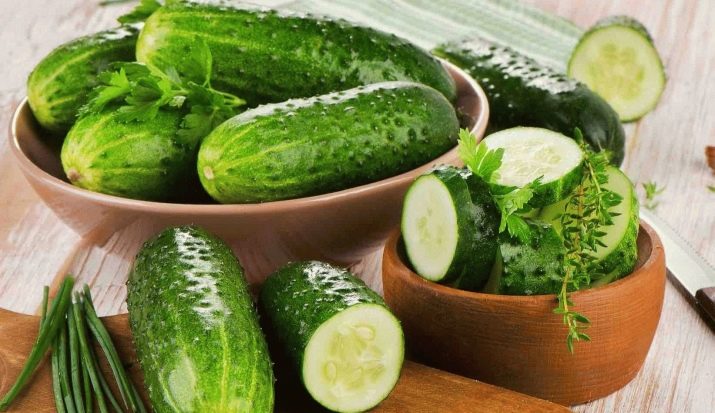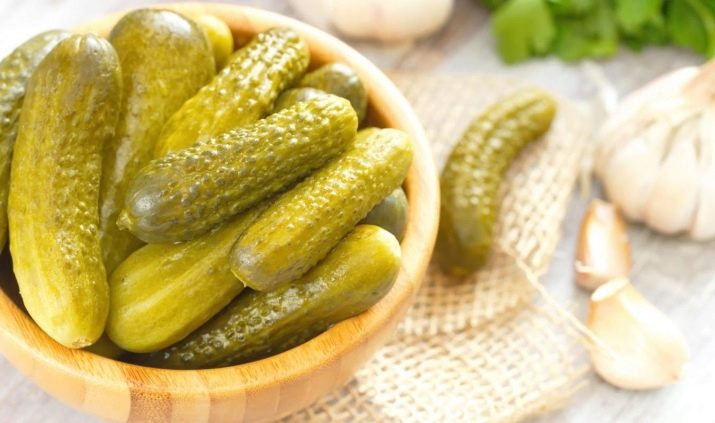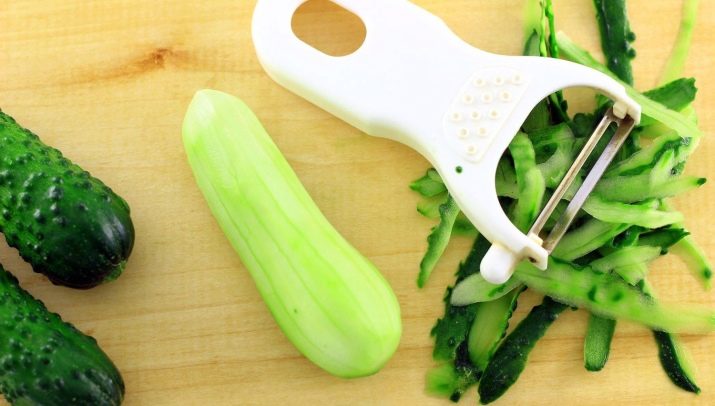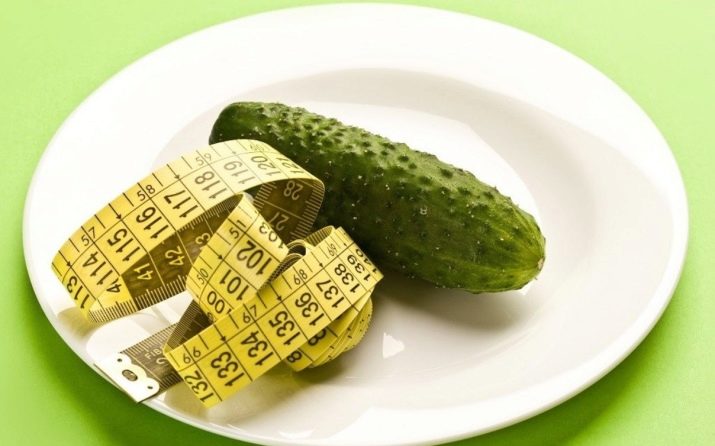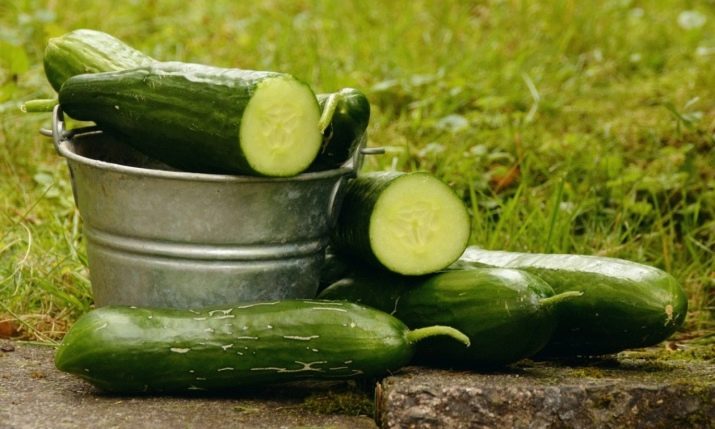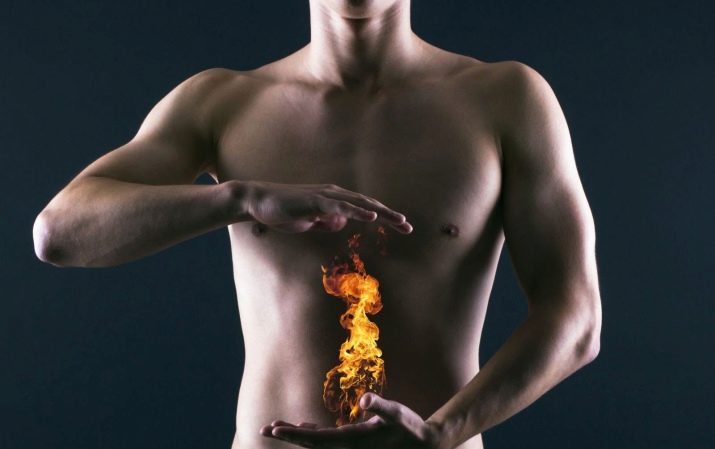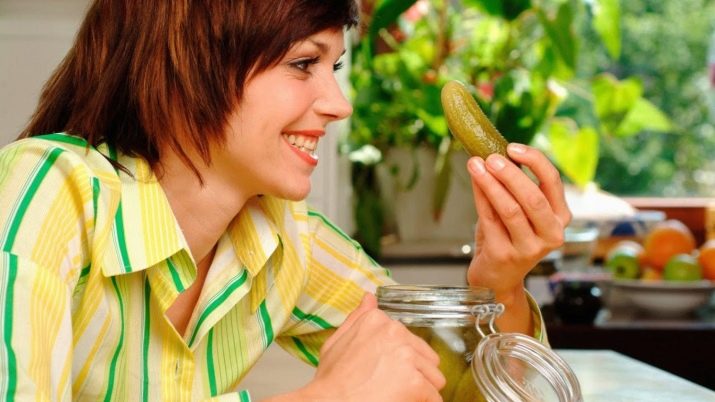Calorie content of cucumber and its beneficial properties
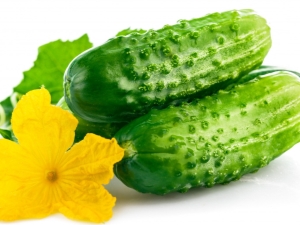
Known on the territory of Russia before the emergence of Kievan Rus cucumber and still is one of the most popular vegetables. The cultivation of the plant has lasted for about 6 thousand years, and India is considered the birthplace of the first cucumbers, from where they came to Asia, and then to Europe, Egypt, and gradually spread throughout the world. Cucumber is suitable for eating fresh, but no less tasty and canned. However, the excellent taste of vegetables is not the only reason for their popularity, since cucumbers can also boast the vitamin-mineral richness of the composition.
Features
Cucumbers are called annual plants of the pumpkin family. They are easily recognizable by the long, creeping stem on the ground, which is strongly branched. However, if you take a closer look at the cucumber bed, you will find that there is a main stem, from which branches of the first order run, from them - branches of the second, etc. The length of the main stem varies from 2-5 m. It is slightly smaller when cultivated in the open field, longer - in the greenhouse. Tendrils are also formed on the lateral stems with which the plant can cling to the supports.
The plant is monoecious, its flowers are opposite-sex. Usually on one stalk there are immediately both female and male inflorescences. Slightly less common bisexual inflorescences. For fruiting, it is necessary to pollinate plants with bees, wasps, bumblebees, ants and other insects that carry pollen from male flowers to female ones. Today, there are also self-pollinating, or parthenocarpic, cucumber varieties.
Fruits of oblong-shaped green color are used for food, having more or less pronounced bumps on their surface (depending on the variety). The size of the fruit depends on the belonging to one or another variety. The size of the fruit cucumbers are divided into the following types:
- the smallest are called pickles, their length reaches 3-5 cm;
- if the vegetable grows within 5-9 cm, it is a gherkin;
- Zelentsy are cucumbers, from 9 to 30 cm long.
From the point of view of botany, this fruit is more correctly attributed to the berries, but it is customary to consider the cucumber to be a vegetable. The inner part of the fruit is soft, juicy, crisp. In addition to the pulp inside there are small edible seeds.
Composition
The chemical composition of cucumbers to a greater extent (about 95%) is represented by structured water. This fluid is necessary for washing the kidneys and liver, helps remove toxins and decomposition products from the body. It is significantly different from the one that man drinks. By its purity and softness, it can be compared with distilled water, but at the same time a large amount of minerals is dissolved in it.
The vitamin composition is represented by vitamins A, B1 and B2, PP, as well as ascorbic acid, and provitamin beta-carotene is also present. The mineral composition is iodine, iron, magnesium, potassium, zinc, phosphorus, etc. In cucumbers you can also find folic and caffeic acids, as well as unique tartronic acid, which can slow down the formation of fat. The composition also has dietary fiber, starch, fructose and glucose.
Nutrition and energy value
Juicy cucumber is a low-calorie vegetable. Its nutritional value is 15 kilocalories per 100 g of fresh produce. The balance of BJU is as follows - 0.8 / 0.1 / 2.8 g. The caloric content of winter preparations based on this vegetable depends on the method of preparation. In general, the energy value of fresh, pickled and pickled cucumbers does not differ much.
However, we must not forget that in the process of conservation products may lose certain properties and acquire new ones.
Fresh
In a fresh cucumber, nicotinic and pantothenic acids are present in large quantities. The first is necessary for the implementation of the process of respiration of tissues, improves blood flow, helps the liver to process and remove toxins, participates in the process of digestion, improving the bowels.Pantothenic acid is responsible for the water-protein balance, and also increases the reducing properties of the body.
High content in fresh vegetables iodine, slightly less iron, fluorine, zinc, manganese. There are also natural saponins involved in the suppression of pathogenic microflora. It is they who provide an easy bitterness of a vegetable.
As already mentioned, the content of structured water is high, the caloric content is 15 kilocalories (kcal) per 100 grams of product. If you clean the cucumber from the skin, then its caloric content will be reduced to 12 kcal, this happens due to a decrease in the carbohydrate content.
On average, 1 pc. cucumber (namely, these are recommended for eating fresh as the most delicious) is 90-120 g. This means that it contains 14-18 kcal with lead in carbohydrates in the composition.
In fresh cucumber juice contains 14 kcal per 100 ml. It does not contain dietary fiber, therefore, is absorbed much faster than the fetus, but differs in the richness of the mineral-vitamin complex in its composition.
If you sprinkle cucumber with salt, its calorie content will not decrease.
Do not be afraid of the fact that the salt will adversely affect the bile ducts, clogging them, cause swelling. Unless, of course, you put a finger-thick layer of salt on a cucumber.
Often, cucumbers are eaten with mayonnaise, which significantly increases the nutritional value of the dish. You can accurately calculate its caloric content by adding the amount of calories of both ingredients. On average, this figure reaches 53 kcal per 100 g of lettuce, while significantly increasing the amount of fat and "bad" cholesterol.
Fans of Japanese cuisine are often interested in how many calories contain classic rolls with cucumber. The approximate figure is 93 kcal per 100 g. In general, this dish can also be called a dietary one. True, if fresh cucumbers can and do not fit into your daily KJVU (with a moderate amount of their use), then the rolls are still a full meal.
Salty
In the process of salting in vegetables increases the concentration of acid, which increases intestinal motility, contributes to lower blood pressure, and also clears the vascular system from cholesterol plaques. Fiber level, contrary to the existing opinion, is not reduced in pickles. But in the composition there are special substances that provide the antibacterial effect of the vegetable, suppress pathogenic microflora. In addition, in the process of fermentation, lactic acid is formed, which is necessary to restore and grow muscles, maintain protein metabolism in the body.
In the process of salting, the amount of antioxidants is somewhat reduced, which cannot be said about potassium, calcium and iron:
- the first is necessary to increase the endurance of the heart, the elasticity of its vessels;
- iron participates in blood formation, allows maintaining the process of transporting oxygen by blood to tissues;
- Calcium is necessary for the strength of the skeleton, as well as for maintaining a normal blood clotting rate.
In general, the composition of pickled cucumber compared to the composition of fresh remains unchanged. The only exception is the level of sodium content, which in salted cucumber exceeds the content in fresh by 113 times (1111 g of sodium per 100 g of pickled cucumber, 8 g - for the same amount of fresh).
The calorie content of pickled cucumbers also remains low - 11 kcal per 100 g of product, in a small cucumber 8-10 cm (these are usually taken for salting) contains about 8-9 kcal.
However, due to the higher salt content, the appearance of edema is possible. Salt itself retains moisture in the tissues, and in addition, provokes thirst.
Salted cucumbers have a similar nutritional value, it is 11 kcal per 100 g. However, their salt content is lower.
Marinated
In cucumbers, prepared by the method of pickling, acids are stored. This suggests its beneficial effects on the organs of the digestive tract, the processes of digestion.However, most vitamins in the process of marinating is lost. The energy value of the dish increases slightly - up to 16 kcal per 100 g of product.
If fresh cucumber due to its high content of moisture and other components gives a feeling of saturation, then pickled, on the contrary, enhances the appetite.
Obviously, pickled cucumbers should be abandoned for obesity. Do not include them in the diet with hypotension, serious heart disease, gastritis, ulcers, gallstone diseases, acute forms of kidney disease.
In pickled cucumbers at a fairly high level, the content of iodine is maintained, so this food is useful for the thyroid gland. As with pickling, lactic acid forms in them during fermentation of pickled cucumbers.
Due to the presence of vinegar, a high concentration of salt and acids, as well as the presence of spices, pickled and pickled cucumbers can be consumed only in the absence of contraindications and not more than 200 g per day.
Benefit
Vegetable with a high amount of water perfectly quenches thirst, but its main value is, of course, in the vitamin and mineral richness of the composition.
Due to the presence of dietary fiber cucumber has a mild laxative effect, and also improves digestion, activating intestinal motility, increases the secretion of gastric juice. The last action is more pronounced when consuming salted and pickled cucumbers. Due to the presence of fiber, the processes of conversion of carbohydrates into fats are slowed down, a feeling of fullness is quickly achieved.
Like a panicle, dietary fiber from a cucumber collects all toxins and slags from the body and removes them to the outside. As a result, it is possible to get rid of the feeling of heaviness, abdominal distention, increase immunity (the majority of immune cells are located in the intestine).
Finally, in the vegetable there are special enzymes that allow you to break down animal protein faster, which, together with the properties described above, makes cucumber a dietary product. It is recommended to regularly include in your diet to people following the principles of healthy eating. On the basis of cucumbers, there are even dietary complexes that allow you to lose weight.
The optimal combination of salts, as well as a sufficient amount of potassium allows cucumbers to remove excess fluid from the body, saving from edema. In addition, the vegetable has a small diuretic effect. Cucumbers are shown for diseases of the kidneys and liver, cystitis.
The presence of salts and iodine makes cucumbers one of the means of preventing diseases of the thyroid gland. A part of the zinc makes it useful also to prevent diabetes, improves the condition of patients. Finally, potassium has a strengthening effect on the heart muscle.
Cucumbers are recommended to be used daily by people engaged in intellectual work, as well as those predisposed to the development of Alzheimer's disease. It turns out that there are fisetins in the vegetable composition, which contribute to the recovery of brain cells, protecting them from age-related changes.
The composition of cucumber juice is high concentration of calcium, phosphorus, mineral salts, which has a positive effect on the state of tooth enamel, skin, improves memory and concentration. It is easily absorbed by the body, recommended for rheumatism, intoxication, improves vision, facilitates digestion.
When used externally, it exhibits an antibacterial and healing effect, and also helps to narrow pores, moisturize and whiten the skin. Antioxidants in vegetable composition, and this is beta-carotene, ascorbic acid, slow down the aging process, which, with regular eating of vegetables, has a beneficial effect on the skin. She becomes tender, radiant, her tone increases.
Cucumber pickle will help relieve spasms and convulsions, is well known as an antiharm agent due to its ability to excrete toxins and toxins from the body, refresh and quench thirst.
The important point is that the eaten fresh vegetable just picked from the garden will bring the maximum benefit. Studies have shown that even 15 minutes after the separation of the fetus from the stem, the concentration of nutrients in it decreases. In the case of vitamins that have been ripped off more than a day ago, the amount of vitamins is reduced by 15-20%.
You will learn more about the beneficial properties of cucumbers by watching the following video.
Contraindications
Contraindications to the use of cucumbers is the individual intolerance of the vegetable. Allergy to him, though rare, but occurs. As a rule, it is manifested by abdominal pain, bloating, difficulty in digesting food up to intestinal obstruction.
Those who have an increased acidity of the gastric juice should also refuse to consume it. You should not include in your diet cucumber also with exacerbation of peptic ulcer and duodenal diseases, gastritis, pancreatitis.
Despite the beneficial effects of the vegetable on the kidneys and liver, it is strictly prohibited in the acute stage of diseases of these organs. Jade, acute renal failure, etc. should be a contraindication to the use of cucumbers.
We must not forget that cucumbers have a laxative effect, therefore, in case of certain problems with the chair, the use of vegetables is undesirable. This should be remembered during lactation. Eating cucumbers by a nursing mother can cause abdominal pain and diarrhea in infants.
Cucumbers of early varieties may contain a high concentration of fertilizers and nitrates, which can cause poisoning. It is not recommended to buy vegetables in early spring, when they, in all likelihood, cannot ripen naturally.
You can protect yourself by eating early varieties of vegetables by peeling off the skin (usually it concentrates most of the nitrates), as well as cutting off the tips of the fruit.
Violent disputes cause cucumber diets. At first glance, they give a stunning result, however, it is important to understand the cost for the body and health of a taut figure.
It is necessary to distinguish the diet, which includes a sufficiently large number of cucumbers, and the manner of nutrition, based almost exclusively on the consumption of this vegetable.
In the first case, a person receives balanced meals, for each or almost each of them 1-2 cucumbers. Such a menu (provided that the other dishes are appropriate or close to healthy and healthy) is optimal. Vegetable acids provide better digestion of food, the breakdown of proteins and fats. Everything that is not absorbed by the body, along with fiber is displayed outside. Additionally, cucumber provides vitamins and trace elements.
Cucumber based diets require a lot of greens and cucumbers, herbal teas or kefir. Low-fat fish or rice, vegetable broth is usually ingested once a day. What happens to him during this period?
- First, the acids from the vegetable provoke increased production of gastric juice, but, in fact, they have nothing to digest. It turns out that the juice and acids begin to actively influence the walls of the stomach.
- Secondly, with such a diet, the body loses the required number of calories, protein and fat. Carbohydrates also comes in small amounts. This can provoke, at a minimum, a feeling of weakness, fatigue, as a maximum, serious diseases, up to dystrophy. Lack of protein and a general lack of calories affect the appearance - the body becomes slimmer, but loses its elasticity muscles.
Lack of fat is extremely dangerous for the female body. Dry fading skin, brittle hair and nails, the cessation of menstruation - all this speaks of a shortage of fats in the body and serious hormonal disruptions.
Doctors warn that the effects of a cucumber diet can be a significant reduction in blood pressure, indigestion, diarrhea, abdominal pain and flatulence.
Despite the fact that the network has a lot of reviews about the positive effect of the diet - it takes 2-5 kg for a couple of days and up to 10 kg per week, to eat in this way is always impossible. As soon as a person returns to the traditional diet, the body that has undergone stress returns the lost kilograms, and more than that - as a reserve.
Finally, such a rapid weight loss is dangerous for the body, because, as already mentioned, this can trigger dangerous hormonal processes.
What conclusion can be drawn from the above? Of course, the fair thing in this case is the idea that everything is good in moderation and even such a useful vegetable as a cucumber can cause serious pathologies if it is used incorrectly and cause harm to the body.
Is it possible to eat after removal of the gallbladder?
Answering this question, it should be noted that the period of recovery of the body after the removal of the gallbladder can be divided into 3 stages. For each of these periods, different dietary tables are provided.
In the first one and a half to two months, the digestive system and the whole body as a whole adapt to the changes that have occurred. Removal of the gallbladder means that now the bile from the liver immediately enters the duodenum, but its concentration does not correspond to the norm. As a result, the processes of digestion slow down, which in turn, causes new diseases of the digestive system and exacerbation of existing chronic ones.
During this period, you should abandon the consumption of coarse plant fiber in food, because it is still too heavy for the digestive system. For this reason alone, it is worth refusing cucumbers in the first months after the operation. In addition, they provoke an increase in the acidity of the gastric juice, which causes heartburn and may provoke an exacerbation of pancreatitis.
It is primarily about fresh vegetables, it is clear that they are also banned in salted and pickled form due to the high content of acids, the presence of vinegar in the composition.
After 2-2.5 months after the removal of the gallbladder, the patient is allowed to eat some vegetables in baked and raw. This list usually includes beets, carrots, pumpkin, zucchini.
Cucumber will appear here only after 4-6 months after surgery. You need to enter it in small quantities, listening to the response of the body. If negative reactions appear in the form of exacerbation of pancreatitis, feelings of heaviness, heartburn, this means that the body is not yet ready to digest the vegetable. It is necessary to use a cucumber, previously having removed from it a thin skin and having cut off tips.
The use of pickled and pickled cucumbers is allowed, but not highly recommended, no earlier than 2 years after surgery. The acid content in such products is significantly increased, which contributes to the erosion of the intestinal mucosa. The situation is aggravated by the spices and salts used in the marinade. The abuse of such food usually ends with the appearance of sharp pains, as well as intoxication of the body.
The appearance of the latter is due to the fact that spices enhance the formation of bile, but there is no reservoir for its storage. As a result, bile begins to actively enter the blood.
As a rule, after the operation, diet table No. 5 is recommended, which does not imply a strict ban on the consumption of cucumbers. In any case, it is necessary to adhere to the recommendations of the doctor and listen to the reaction of the body.
Tips
The most useful are freshly picked vegetables grown in open ground at home with minimal use of fertilizers and special means. Greenhouse cucumbers are somewhat inferior to the soil in their benefits and taste.
As already mentioned, it is not recommended to eat excessively early cucumbers.Their composition may exceed the concentration of nitrates and other "chemistry". If such fruits are still used in food, they must be removed from the peel and cut off the tips.
Fresh cucumber can be identified by its appearance - it should be bright. Yellow spots, as well as the general sluggish appearance, indicate that the cucumber was torn off for a long time. The sluggish, dry tail also testifies to this. About freshness says and rich fresh flavor. It is felt even in uncut fruits.
Choose fruits that have a uniform color, unless otherwise specified by the characteristics of the variety. Do not eat fruits that have dark or light spots on the surface. The first, as a rule, talk about rot, the second - about the bitterness of the vegetable.
Pimples on the surface must be dense, not damaged. They should not be too much. The opposite, especially if the pimples are sharp, can be a sign that the plant is “overfed” with nitrates.
Do not eat and buy cucumbers that are damaged. Such fruits have lost some of the juice, and the violation of integrity has led to the penetration of pathogenic microbes.
If in the process of selecting cucumbers you find that they are wet, give up the purchase. Most likely the seller kept them in cold water for the return of a fresh presentation. You should not take and coated cucumbers. Externally, these fruits have a nice glossy look and look very attractive. However, wax can be applied to the ripe and faded fruit.
For consumption, it is better to choose small cucumbers, 5–12 cm long, for salting - no more than 9–10 cm. Too large fruits turn out to be too watery, contain large seeds and can be bitter. For salting it is recommended to choose fruits with light pimples, for canning - with black ones.
It is better to wash cucumbers immediately before use, because losing a protective layer, cucumbers begin to fade faster.





